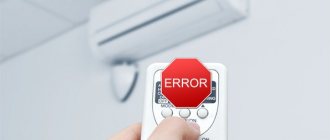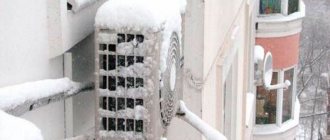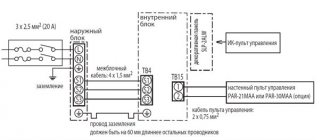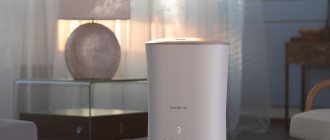Air conditioners and split systems with FREE installation
Working for cooling, the split system always dries the air. Warm air currents hit the radiator and condense. The resulting moisture flows through the drainage hose to the street. As a result, up to 2 liters of condensate can evaporate per day.
When the dehumidification function in the air conditioner is turned on, almost the same process occurs, with only minor differences in the operation of the split system.
More details Maintenance of split systems Price from 500 ₽ for maintenance
Design and principle of operation of an air conditioner with dehumidification
To understand the operating principle of the dehumidification option, let’s clarify the general design of air conditioners.
The operation of the device is based on changing the properties of the working substance - the refrigerant.
It goes through four states: compression, condensation with the release of heat, expansion, evaporation with the release of cold.
Modern multifunctional split systems consist of two blocks: external and internal.
Components of the external block:
- The fan forces air into the system.
- The condenser cools and condenses the freon.
- The compressor compresses freon and ensures general circulation of the working fluid throughout the system.
- The capillary tube expands the working substance.
- Four way valve. Provides modification of the refrigerant circuit for the heating function.
- Filters clean the air flows entering the condenser and prevent contamination of the unit elements.
The indoor unit consists of the following elements:
- The front panel with a filter ensures air intake from the room.
- Filter system.
- Fan.
- The evaporator cools and heats the air.
- Blinds for adjusting air flow directions.
- Control board.
- Indicator panel.
The principle of operation of an air conditioner in the cooling and heating processes. From the compressor, the working substance in a compressed gaseous state is sent through tubes to the condenser. Under the influence of pressure, condensation occurs with the release of heat. The heated freon is directed through a capillary tube, which reduces the pressure. The gas-liquid mixture enters the evaporator. In the evaporator, the freon is cooled and transfers the cold to the air flows that enter the room. The refrigerant gas is returned to the compressor. This results in a closed cycle of movement of the working substance.
In heating mode, the circuit of movement of the working substance is switched. Cooling of freon with heat intake occurs in the external block, and heating with heat release occurs in the internal block.
Air conditioner operating modes
An air conditioner is, first of all, a device for maintaining the desired temperature in a room. The transfer of air conditioners from one mode to another occurs both manually and from a remote control. In any price category there are air conditioners with the same functionality.
The presence of operations on it depends on the configuration. As a rule, a household unit has several functions that are designated on the air conditioner remote control in the form of intuitive symbols. What modes the icons and inscriptions symbolize will be discussed in this article.
General air conditioner modes
The basic functions of an air conditioning device are found in every classic product, and they have designations of air conditioning modes in the form of symbols and inscriptions in English. However, most of these words require translation.
In this row, you can determine what functions the air conditioner performs in the form of the following inscriptions and signs:
- Cool – coolness, indicated by a snowflake.
- Heat – heating, there is a sun icon.
- Dry – drying, icon – drop.
- Fan speed – ventilation, a propeller is shown next to the inscription.
- Sleep – night auto mode. Star symbol.
- Timer – timer. Image of a clock.
- Swing – direction of air flow through curtains.
- Lock – child lock button.
When choosing an air conditioner for your home, you usually determine, first of all, energy consumption, and, of course, the minimum possible operations. And although the functions of the air conditioner: air dehumidification, ventilation, ionization and disinfection are not so noticeable at first glance, they significantly increase the comfort of living when using them.
What functions does the air conditioner perform?
The microclimate plays a huge role in a person’s comfortable living. Undoubtedly, being in a room with optimal temperature and normal humidity is much more pleasant than being in a room where it is hot and stuffy.
Although the main task of an air conditioner is to create a cool air flow, it also has other important settings, switching to which will improve the standard of living for household members.
Cooling the room
Each air conditioner is designed primarily to cool the air mass in the room. Switching to this mode is done on the remote control with a button where a snowflake is depicted, which means “cold”.
Good to know! Coolness occurs through a physical process, or, more precisely, the transformation of a substance (refrigerant, freon) from liquid to gaseous state.
When the air conditioner is in auto cooling mode, it turns on when the room temperature rises. After the degree readings have reached their configured value, the compressor in the external module is turned off (if it is a split system). For better comfort, the fan speed in the indoor unit is automatically adjusted depending on the room temperature.
The speed of the outdoor fan changes depending on the condition of the outdoor unit's capacitor. As soon as the moisture release decreases, which means the pressure inside the tubes drops, the compressor turns on and the speed of the fan located outside increases.
At this moment, the warm air formed around the condenser is discharged outside, and the icy refrigerant is driven into the evaporator of the indoor module. The heat exchanger is made in the form of a radiator (copper tubes are fastened together with aluminum plates). Cold air, passing through the grilles, is accelerated by a fan throughout the room.
Heating the room
When the temperature in the room drops, the automatic “cooling” mode switches to the “heating” mode. This is achieved through a 4-way valve, which changes the movement of the refrigerant. And as a result, the outdoor and indoor units change places, or, more precisely, the evaporator works as a condenser, and that, in turn, as a radiator.
Most often, the heating function is designated “heat”, which in Russian for an air conditioner means “heating”, “warmth”. A sun symbol is usually depicted next to the inscription. To switch the air conditioner to the automatic “heating” mode, you need to press the button with a miniature image of the sun and the light on the display should light up.
Air conditioner operation in heating mode
Air dehumidification
Air humidity in residential premises should be 40-60%. Sometimes it happens that this indicator is higher, and increased humidity creates discomfort. The function of dehumidifying the air mass with an air conditioner is simple.
Moist warm air passes through a cold evaporator (heat exchanger) and as a result, water from the air condenses on the surface. Moisture gradually accumulates in special containers and is then removed through the drainage system to the street.
In general, the dehumidification function can be divided into three stages:
- Dehumidification from the remote control button.
- Automatic drying.
- Switching to air ventilation and drying mode depending on the humidity indicators of the device.
Attention! When the air conditioner operates for dehumidification, the air does not heat up and the temperature in the room remains unchanged, contrary to the opinion of some ordinary people.
Fresh air supply
Over the past decade, supply-type air conditioners have appeared on the market. They differ from traditional split systems by the presence of a ducted air duct, in the system of which atmospheric air can be mixed up to 25% of the device’s power.
An air conditioner with such a mixture has a built-in membrane that regulates the operation of the channel. At the same time, its characteristic property is unequal throughput: oxygen molecules pass through such a membrane much faster and better than molecules of other gases.
What is the dehumidification mode in an air conditioner?
The dehumidification mode in the air conditioner is a program that helps reduce air humidity to a normal level. At the same time, a special system removes excess water from the flowing air while maintaining a comfortable temperature background. The optimal indicator of air humidity in residential premises is the range from 40 to 60%.
An increase in this value leads to:
- deterioration in people's well-being;
- the development of fungi on the surface of the walls;
- proliferation of pathogenic microorganisms.
This mode helps dry the air, making it more comfortable for humans. This function is inherent in “premium” or “middle” class systems. On remote controls it is displayed with a special icon.
The principle of operation of drying in an air conditioner
Air dehumidification refers to a mode of equipment operation in which a special system removes moisture from the flowing air and supplies it to the room. There is no decrease in temperature.
How the drying mode works
To enable the drying function on the air conditioner, you need to run the Dry option (the meaning of the word in Russian is “drying”). Depending on the model, the Dry option is located as a button on the panel or as a separate line on the touchpad. The option can also be activated using remote controls. The exact algorithm for using the option is specified in the technical data sheet of the system model.
The mode under consideration is similar in principle to the air cooling function.
It works according to the following algorithm:
- the radiator of the indoor unit is cooled;
- the air pumped by the fan comes into contact with the surfaces of the radiator and gives off its heat;
- moisture from the flowing gas falls in the form of condensation on the walls of the radiator;
- special tubes collect liquid and discharge it through a drainage hose, which should be installed next to a special container for collecting water;
- The air entering the room loses temperature and cools the indoor climate.
Drying in an air conditioner reduces indoor humidity
The drying option works according to the following rules:
- the cooling system turns on;
- when the radiator reaches a certain low temperature, the sensor is triggered and the fan is commanded to reduce rotation speed;
- the air flow speed decreases;
- Condensation continues to form;
- the discharge is too slow and the dehumidified air does not have time to lower the temperature in the room;
- when certain temperature reduction parameters are reached, the sensor sends a command to completely temporarily turn off the fan;
- The fan turns on and off periodically.
When drying, maintaining a comfortable temperature supplied to the room is facilitated by the presence of a special valve. The valve shuts off the flow of freon into the heat exchanger.
The drying mode of the air conditioner can be set to turn on automatically
Approximate operating mode of the air conditioner during dehumidification:
- Dehumidification runs for 10 minutes;
- The device is turned off for 5 minutes;
- The fan works hard for 2 minutes;
- the cycle repeats.
Air conditioner mode Dry - dehumidification
The drying function is marked on the air conditioner remote control with the inscription Dry. This option is useful for people living in regions with high air humidity. The activated dehumidification mode absorbs moisture for 10 minutes, followed by a 5-minute break with the fan turned off, and then the turbo ventilation mode starts for 2 minutes.
The dehumidification mode in split systems not only removes excess moisture from the air in the room, but also prevents the appearance of mold and mildew.
Operating principle of the “drying” mode
The principle of operation of climate control equipment in the specified mode begins with the launch of the “Dry” option. Translated into Russian, this concept is interpreted as “drying”. The location of the described option can be on the touch panel in the form of a line or placed as a separate button on the remote control. This program starts working by pressing the remote control.
The operation of a dehumidification system is similar to that of air cooling:
- radiator cooling in the indoor unit;
- contact of air masses forced by the fan with the radiator walls;
- heat transfer by air;
- condensation of moisture from the air onto the surface of the radiator;
- collecting liquid with special tubes and then removing it through a drainage hose;
- return flow of cold air into the space.
Please note: A container must be installed next to the drainage hose to collect the draining liquid. Periodically it requires emptying!
Approximate cycle of operation of a split system:
- drying (10 min);
- switching off the device (5 min);
- increased ventilator activity (2 min);
- repeat the cycle.
What is the dehumidification function for in an air conditioner?
Air conditioning dehumidification is necessary when:
- Living in areas of high humidity.
- The placement of devices in the apartment that excessively humidify the air.
- The harmful effects of excess humidity on household appliances and books.
- Increased risk of mold growth.
- Mustiness in the rooms.
- Flooding of space due to burst pipes.
Not all climate systems dry the air the same way! Rooms with excessive moisture require powerful equipment that can dry quickly.
There is a category of citizens who do not tolerate high air humidity. Because of this, their existing diseases not only worsen, but also the risk of developing rhinitis, asthma or allergies increases. Therefore, it is worth installing an air conditioner with a “drying” function in the premises.
You may be interested in: Replacing freon in an air conditioner
Purpose of the drying function in the air conditioner
The function of supplying dry air in an air conditioner is advertised by manufacturers as a significant functional advantage. It is necessary, but not always.
Drying mode - three drops icon
When the drying option is needed:
- Living in regions with high humidity. The supply of humid air into the room will lead to damage to furniture, doors, books, household appliances, etc. Favorable conditions are created on the walls and in the corners of the premises for the development of fungi and mold. A mustiness appears in the atmosphere of the room.
- Flooding of the premises after burst pipes or breakdown of plumbing systems.
- There is equipment in the room that excessively humidifies the air. The room is designed for work that releases large amounts of liquid into the air. It is worth clarifying the functionality. Many air conditioners will not be effective when drying rooms with a lot of moisture (swimming pool, etc.).
- Poor tolerance of the body to high humidity, the presence of a disease for which such a climate is contraindicated.
- It is recommended for the health of all people if the indoor humidity level deviates from the optimal levels - 45-65%. With increased moisture, the likelihood of developing allergic reactions, asthma or rhinitis increases. You can’t live in dry air either. In such a situation, the likelihood of problems with the respiratory tract, skin, and general condition of the body increases.
It is especially important to maintain humidity levels in apartments where small children live.
You need to use the moisture removal option carefully. It is important to monitor the moisture level when working and use the function only if the level is seriously exceeded or there is a constant “upper” deviation from the norm. You need to focus on a regime with 50% humidity and a temperature of about 18-20 °C.
Advantages and disadvantages of dehumidification mode
The process of drying air with a climate control system has its disadvantages:
- Failure of the device leads to loss of the “Dry” function.
If the unit fails, the air conditioner will not be able to dry the air.
- It is not advisable to use in winter.
In winter, the dehumidifier will remove the already low moisture content from the air (the main amount will be dried by the heating system). Lack of fluid in the air space stimulates the development of hair and skin problems.
- An excessive number of options interferes with the operation of the basic functions of the climate system.
The wide functional list of the air conditioner contributes to the creation of increased load on the unit. As a result, the effectiveness of all equipment may be reduced. When purchasing, you should choose models with the optimal set of options that will be used in the household.
- Reduced effectiveness of the “temperature increase” option.
You may be interested in: Features and selection of air conditioner power
In the winter season, the “drying” function will not be able to create a full-fledged operation of the “heating” program.
Despite so many disadvantages, the “Dry” option also has its advantages:
- Indoor comfort.
Timely turning on and off of this mode will create the most optimal microclimate in the room, taking into account the preferences of all family members.
- Space saving.
When and how to turn on the dehumidification mode in the air conditioner
As you know, heat is more difficult to tolerate in high air humidity; therefore, in such cases, turning on the “Dry” option allows you to breathe more comfortably. You can turn it on if necessary by pressing the corresponding button on the remote control or by clicking on the desired menu line. The “Dry” option leads to the disappearance of stuffiness, making the air more comfortable to breathe. By the way, the temperature background does not change!
Most household split systems are capable of removing excess moisture from the air, while minimizing the risk of developing many unpleasant consequences for the body and apartment. Thus, setting the set temperature in the room leads to the inclusion of the “Dry” mode. As soon as the humidity becomes optimal, a sensor is triggered giving a command to reduce the fan speed.
A special valve helps maintain a comfortable temperature for residents in the room when the “drying” option is turned on. It is its activity that helps block the flow of freon to the heat exchanger.
Of course, the inclusion of a “drying” function in the air conditioner is a big plus for its owners. You just need to use such a unit when necessary, otherwise the dried air can negatively affect many interior items and human health.
Step-by-step instructions for turning on the air conditioner in dry mode
Before turning on the air conditioner, make sure that it is connected to the mains (the plug is plugged into the socket or the corresponding circuit breaker is turned on in the electrical panel).; Next, take the control panel and follow the steps in the step-by-step instructions for turning on the drying mode:
- Turn on the air conditioner by pressing the on/off button.
- a droplet or the word Dry appears on the remote control display .
- Next, use the Temp buttons or arrows to select the desired temperature. For example, we set it to 25 so that the air conditioner does not lower the temperature in the room below +25 degrees. Because In the drying mode of the air conditioner, its main task is to dry it, it is not a fact that it will maintain the set temperature.
- If you need to change the fan rotation speed, press the “Fan Speed” button (there may be “Fan” or “Speed” buttons).
- If you need to change the direction of the blinds flow, then look for the Swing button.
Long-term operation of the air conditioner in dehumidifying mode
During drying, the air conditioner operates for about 10-15 minutes, then turns off for 5 minutes. Then the fan turns on for 2-3 minutes. After this, the cycle repeats.
To control the drying of the room, you can use a hygrometer. As soon as you see that the humidity has dropped, you can turn off the device or turn on the cooling.
Long-term operation of the system for dehumidification is fraught with dry air. In such conditions, the mucous membranes begin to dry out, a sore throat appears, and the skin dries out. Therefore, you should not constantly enable this function unless necessary.
Do you need a dehumidification mode in your air conditioner?
The device will dry the air in any case; The presence of a separate Dry function will allow you to get rid of excess humidity without cooling with an air conditioner.
This option will be useful in the following situations:
- When high moisture content in hot conditions makes it difficult to breathe and creates a tropical effect.
- If you live in a humid climate.
- After the apartment was flooded by neighbors.
- When there is high humidity in the apartment due to poor ventilation.
High temperatures in a damp room are much worse tolerated. The body does not have time to give off heat, and the person runs the risk of heatstroke.
It is enough to reduce the humidity by at least 10% to feel better. And parameters of 30-60% are considered optimal indicators.
By understanding how dehumidification works in an air conditioner, you can regulate the humidity in the room (if it is high, of course). It is not possible to increase the moisture content with such a device. Any “humidifying type air conditioners” are not air conditioners as such, they only create “tropics”.
How does it all work?
Dry
There are quite a lot of air conditioners with a dry function on sale now. The design includes a special valve that distributes freon pressure in a certain way. As a result, the upper part of the evaporator heats, and the lower part collects condensate. In turn, the fan mixes cold and warm air. As a result, the air conditioner blows a warm, dry stream. The condensate drains independently through a special hose to the street.
The mode is used without reducing the temperature. This allows you to maintain a comfortable microclimate in the room, while reducing humidity. In addition, using the dry mode for drying prevents the formation of mold and reduces the risk of colds.
Can maintain indoor humidity between 35 and 60%.
Sometimes users try to reduce humidity using an air conditioner without this function. Here the disadvantages immediately become obvious - without lowering the temperature, drying does not occur.
Heat
This feature helps heat the room when it gets cold. The user sets a certain indicator below which the room temperature should not fall. The air conditioner maintains it by periodically starting and stopping the heating.
Before starting the device in winter (at sub-zero temperatures outside), read the instructions! Models have a limitation on starting at low temperatures!
Many air conditioners can operate for heating when the outside temperature is down to -5. Turning on the device at lower values entails a breakdown, maybe not instantaneously, but quickly. Therefore, you need to find out about the maximum and minimum temperature limits of the device.
If you already have an air conditioner that cannot work, for example, at -10 degrees, this is not yet a reason to go for a new one. Most models, even budget ones, can be upgraded. There are special winter kits that allow you to increase the temperature range of the device. So even an inexpensive air conditioner can act as a heater at -20 degrees.
Fan
This function allows you to adjust the intensity of the air supply. In “fan” mode, only the fan operates, without heating or cooling.
Some models, therefore, provide not only ventilation, but also ionization, cleaning, oxygen saturation, etc. Accordingly, these devices cost a little more and require refilling.
When should you turn on the dehumidification in your air conditioner?
Dehumidifying a room with an air conditioner may be necessary in several situations:
- you live in regions characterized by a humid climate. If you do not use dehumidification, this can lead to unpleasant consequences: swelling of wooden doors, “lumpy” appearance of books, magazines stored indoors, and more.
- the apartment was flooded and you want to dry it out after this unpleasant incident.
- you do not tolerate high humidity well. This often happens to people who grew up in dry climates. Then they moved to more humid regions, for example, to the south.
The influence of air humidity on human well-being
Any deviation from the norm of moisture content in the air leads to unpleasant consequences. First, a person develops allergic reactions, which can transform into a chronic disease.
The second common health problem is rhinitis. A constant runny nose will not allow you to live a normal life. More serious diseases, such as asthma, are also likely to occur.
On the other hand, dry air also has a negative impact on health. Frequent cough caused by dry airways, skin problems and fatigue are an incomplete list of the consequences of this condition.
When purchasing an air conditioner with a dehumidifier function, you are first of all buying a portion of health. An additional incentive will be the safety of things and the entire apartment.
Sources:
- https://morrozko.ru/funktsiya-sushki-v-konditsionere/
- https://konditsionershik.ru/konditsioner-v-rezhime-osusheniya/
- https://vozduhstroy.ru/kondicionery/zachem-nuzhna-funkciya-sushki-v.html
- https://celsis.ru/publikacii/kak-rabotaet-funkcziya-osusheniya-v-kondiczionere
- https://vsekondicioneri.ru/blog/kakie-rezhimy-i-funktsii-est-u-konditsionera/
- https://oventilyacii.ru/ventilyaciya/kondicionirovanie/funktsiya-sushki-v-konditsionere.html
See also:
- Ventilation design
- Which split system is better: inverter or conventional?
- How does a ducted air conditioner work?
- Which is better: climate control or air conditioning?
- How to clean your home air conditioner
- How to choose an air conditioner for your cottage
- How to choose a split system for an apartment?
- How to clean your air conditioner yourself
- How to choose an air conditioner for your home
- Why doesn't the air conditioner blow warm air?
- How to connect the hood?
- How to choose a mobile (floor) air conditioner
- “Fan” ventilation mode on an air conditioner - what is it?
- Supply ventilation mode in an air conditioner - what is it?
- Why does the air conditioner stink?
Humidity and well-being
Even if you were born in a region with high humidity, being in a room where it deviates from the optimal level of 45-65% is fraught with unpleasant consequences. A person’s risk of allergic reactions increases, and rhinitis or asthma may become more active.
On the contrary, if the air is too dry, it will lead to dry throat and respiratory tract, skin problems, and increased fatigue. This has a particularly negative impact on young children.
Therefore, the Dry mode must be used wisely - do not overdry the room, and use this function only when the humidity is really high. Focus on a moisture content of 50% at a temperature of 18-20 degrees.
Read the article on how “split” works in heating mode.











